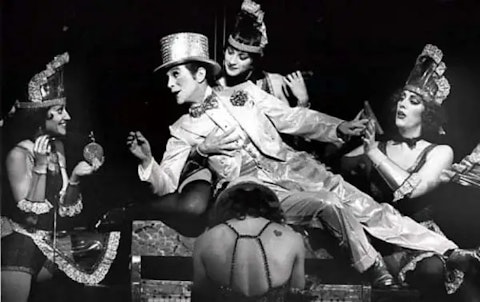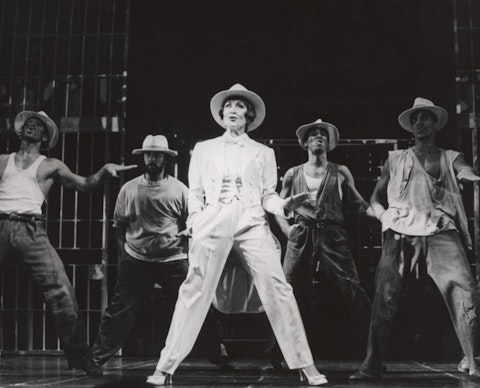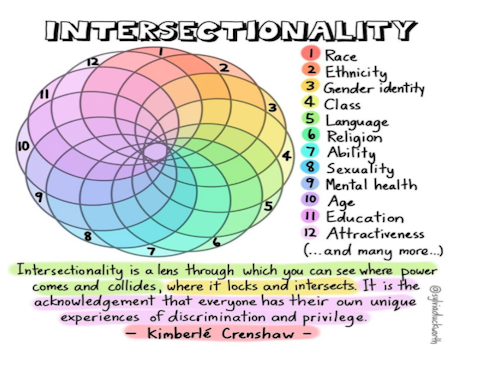The Early Years: Subtext and Secrecy
Homosexuality is known to have been openly practiced in ancient Greek society. Plays of the time referenced or included themes of same-sex love, including those by Aristophanes, Aeschylus, and Plato, and many have interpreted the relationship between Achilles and Patroclus in Homer’s Iliad to have been romantic. Unfortunately, with the Christianization of the Roman Empire, the social acceptance of same-sex relationships evaporated and homosexuality eventually came to be criminalized.
Although playwrights throughout most of history were not able to mention LGBTQ+ themes explicitly, many continued to write about them using subtext and ambiguity. For example, despite heavy censorship and the threat of the death penalty in England during his time, Shakespeare often played with gender in his plays. The closest he comes to an overt portrayal of queer love is in Twelfth Night where the heroine disguises herself as a boy and her male love interest falls in love with her while believing she is a boy. Shakespeare himself is believed to have been bisexual by many historians who cite the large number of his sonnets addressed to a male subject.
Oscar Wilde is known as an icon of the gay rights movement today, but during his time in the late 1800s he was also subject to censorship laws and the threat of criminal punishment for homosexuality. Even so, there isn’t far to dig to reach the queer subtext in Wilde’s plays. He passed off the affection between his male characters as platonic love, but in his novel The Picture of Dorian Gray he seems to have drawn the veil too thin. The novel was condemned as immoral, and when Wilde was eventually tried and convicted of “gross indecency for homosexual acts,” passages from Dorian Gray were read by the prosecution. Fortunately, The Picture of Dorian Gray is better received by modern audiences. It was adapted as a film in 1945 and again in 2009. Sarah Snook has recently won the Olivier Award for Best Actress for her one-woman production currently running in London’s West End.
By the 1920s theatermakers in America were beginning to push back against LGBTQ+ censorship. In 1923 a play called The God of Vengeance by Sholem Asch opened on Broadway which featured a storyline about a Jewish brothel owner’s daughter who has a lesbian relationship with one of the female sex workers. The cast and producer were arrested and charged with obscenity after a performance. Another play featuring a lesbian love affair, The Captive by Edouard Bourdet, met the same fate in 1926. Soon after, New York City passed the Wales Padlock Act which “amended the public obscenity code to ban plays depicting or dealing with the subject of sex degeneracy, or sex perversion." With the threat of their theaters being “padlocked” for a year if they were convicted, producers stopped backing plays with explicitly queer characters, and LGBTQ+ representation once again vanished from mainstream stages.
Breaking Boundaries: The 1960s to the 1980s
The 1960s ushered in an era of rebellion. With the rise of counterculture, young people rejected their parents’ traditional thinking and advocated for civil rights, women’s rights, free love, and peace. Growing unrest in the LGBTQ+ community came to a head with the Stonewall Riots in Greenwich Village, New York City in June, 1969. The weeklong protests are commemorated every year with Pride Month taking place in June.
Cabaret, a musical by John Kander and Fred Ebb, opened on Broadway in 1967. In the original production the queer dynamics of the story were not explicit, although strongly suggested. The 1972 film version, directed by Bob Fosse and starring Liza Minnelli, overtly portrays the male lead’s bisexuality.
In April 1968, a play opened Off-Broadway at Theater Four in New York featuring eight gay characters. The Boys in the Band, written by Mart Crowley, was a landmark in the history of LGBTQ+ theater. Homosexuality was still criminalized at the time, and initially no one wanted to be involved with the show. Eventually, and with the help of fellow gay playwright Edward Albee, Crowley managed to persuade actors and producers to come on board despite the risk to their careers. To everyone’s surprise, the play was a hit. The Boys in the Band ran for two years, and celebrities who attended included Jackie Kennedy, Marlene Dietrich, Groucho Marx, and even the mayor of New York, John Lindsay. The play was adapted as a film in 1970 starring the original cast. A Broadway revival in 2018 celebrated the show’s 50-year anniversary starring some of the most famous openly gay actors of our generation, including Jim Parsons, Zachary Quinto, Andrew Rannells, and Matt Bomer. Netflix released a film version of the revival in 2020 starring the same cast.
The success of The Boys in the Band opened the gates for queer theater. The Rocky Horror Show (1973) debuted at The Royal Court Theatre in London and was one of the first mainstream musicals to depict fluid sexuality. The show was written by Richard O'Brien who has since come out as trans. In 1975 the show transferred to Broadway and was adapted as a film which has become a cult classic.
Another Royal Court show, Bent (1979), written by Martin Sherman and starring Ian McKellan, tells the story of a gay man in Nazi Germany. It was one of the first plays to expose the lesser-known history of gay men being sent to concentration camps. The show transferred to the West End and then to Broadway where it starred Richard Gere who received a Tony nomination for his performance. Bent was adapted as a film in 1997 starring Clive Owen.
The Torch Song Trilogy, a semi-autobiographical play about a gay, Jewish drag performer, written by and starring Harvey Fierstein , began life as three separate plays staged off-off-Broadway. They were combined for a run at the Actor’s Playhouse in Greenwich Village where the cast included a young Matthew Broderick. The show transferred to Broadway in 1982. Another unexpected success, Fierstein won the Tony Awards for Best Play and Best Actor, becoming the first openly gay actor to win a Tony for playing a gay character.
The next year, in 1983, Fierstein wrote the book for the musical comedy La Cage aux Folles. It was based on the 1973 French play of the same name by Jean Poiret, which had been adapted as a film in 1979. Another landmark in the history of LGBTQ+ theater, La Cage was the first Broadway musical featuring a gay couple as principal characters. Despite a spike in homophobia associated with the escalating AIDS crisis, the show was a hit. It ran for four years and won six Tony Awards including Best Musical.
Mainstream Acceptance: The 1990s to 2000s
It wasn’t until the end of the 20th century that LGBTQ+ narratives on Broadway began to gain mainstream acceptance. Plays and musicals featuring queer characters not only increased in number but achieved greater success than their predecessors.
The Kiss of the Spider Woman by Kander and Ebb, based on the novel by Manuel Puig about two men who share an Argentinian prison cell, opened on Broadway in 1993. The show won seven Tony Awards including Best Musical.
Hedwig and the Angry Inch (1998), a musical by Stephen Trask and John Cameron Mitchell about a genderqueer East German rock star, struck a victory for trans representation. It was adapted as a film in 2001, and played on Broadway in 2014.
In 1998 Cabaret returned to Broadway achieving greater success than it had previously. The show won the Tony Award for Best Revival of a Musical and continued to run for six years. A new adaptation is playing on Broadway right now starring Eddie Redmayne and Gayle Rankin.
Avenue Q opened on Broadway in 2003. A parody of Sesame Street featuring a mix of human and puppet characters, the story explores adult themes including racism, homosexuality, and pornography. The show won the Tony Awards for Best Musical, Best Book, and Best Score.
The Boy from Oz, a jukebox musical about the life of singer Peter Allen follows Allen’s journey as a musician and coming to terms with his homosexuality. The 2004 Broadway production starred Hugh Jackman who won the Tony Award for Best Actor.
The 2005 musical adaptation of Alice Walker’s novel The Color Purple brought one of the first stories of Black lesbian love to Broadway. The novel was adapted as a film in 1985 starring Oprah Winfrey and Whoopi Goldberg, and the musical was adapted as a film in 2023.
The Modern Era: Diversity and Visibility
In looking at LGBTQ+ narratives on Broadway, it’s clear the ‘G’ has taken center stage for most of history, with white, cisgender, upper middle class gay men dominating the genre. In recent years the spotlight has expanded to include more letters as well as more representation for intersectional experiences, which are the experiences of people who are affected by more than one form of systemic prejudice (e.g. a person who is queer and BIPOC, or queer, BIPOC, and disabled).
There have been fewer Broadway musicals and plays featuring lesbian protagonists. Fun Home (2015), Lisa Kron and Jeanine Tesori’s musical based on Alison Bechdel’s graphic novel, won five Tony Awards including Best Musical. Paula Vogel’s Indecent (2015), which tells the story of the 1923 play The God of Vengeance, brings us back full circle to one of the first instances of lesbian representation on Broadway. The Prom (2018) draws from the true story of a Mississippi teen who was banned from bringing her girlfriend to the prom. The show was nominated for seven Tony Awards including Best Musical and was later adapted into a film in 2020. Lempicka (2024), currently running on Broadway, tells the story of the real-life, bisexual artist Tamara de Lempicka with a focus on her love affair with a female sex worker.
Like the history of gay narratives, the most prominent lesbian shows also predominantly feature white protagonists. There have been calls for more diversity in LGBTQ+ theater, and mainstream stages are beginning to see broader experiences than those of white, upper middle class people.
Harvey Fierstein’s 2013 hit musical Kinky Boots (based on the 2005 film) starred Billy Porter as Lola, a Black drag performer. The show ran for six years and won six Tony Awards including Best Musical and Best Actor for Porter. Jeremy O. Harris’s Slave Play (2020), which portrays interracial and gay relationships, received twelve Tony nominations, setting a record at the time for a non-musical play. In his musical, A Strange Loop (2022), Michael R. Jackson explores the experience of being gay, Black, and overweight. Body types that differ from conventional ideals are underrepresented on Broadway stages in general, but in LGBTQ+ stories too, with gay culture particularly favoring fit bodies. Disability has also been largely excluded from both mainstream and LGBTQ+ narratives.
The representation for trans characters on Broadway has been limited. Apart from Rocky Horror and Hedwig, there have been just a handful of shows featuring trans characters in prominent roles. The 2018 play The Nap had a short run on Broadway but it starred trans actress Alexandra Billings in the role of a trans woman.
The 2022 musical Some Like It Hot (based on the 1959 film starring Marilyn Monroe) reimagined the story so that the character Jerry/Daphne explores their gender identity and eventually comes out as a trans woman. Nonbinary actor J. Harrison Ghee won the Tony award for Best Actor for their performance in the role. Currently on Broadway, & Juliet features the nonbinary character May played by trans, nonbinary actor Justin David Sullivan. Notably, Sullivan has withdrawn themselves from Tony consideration due to the organization’s gendered categories.
While LGBTQ+ representation on Broadway has made significant progress in recent history, the hope is that we will continue to see more diversity and further exploration of intersectional experiences in future plays and musicals.




